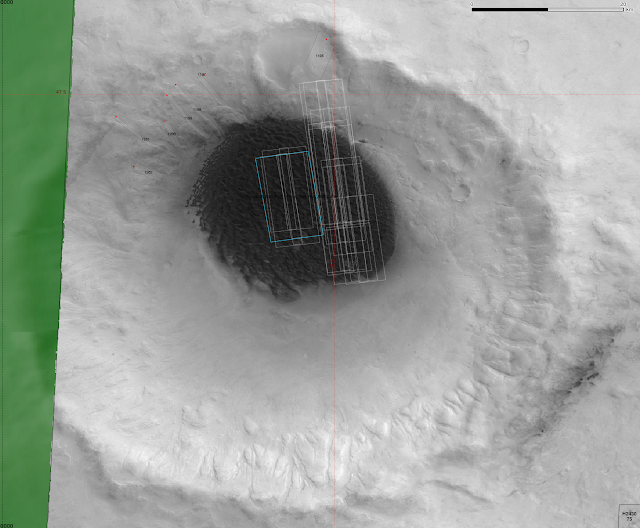Here is a summary map of another region of Mars from my MSc dissertation work, this time the region to the west of Hellas Planitia.
 |
| Elevation (MOLA) blended with underlying MOC image mosaic. |
 |
| All tiles in this region except h2210 use this colour ramp for elevation |
 |
| MOLA elevation only. |
 |
| MOLA elevation blended with hillshade. |
Preview of a single HRSC tile h2210
This is located to the SW of Hellas Planitia, around 47°E, 48°S. The elevations within this tile range from -4542 to 1064m relative to datum.
 |
| Elevation blended with nadir image layer, a single Souness object is visible, but... |
 |
| The classifier predicts substantial areas, which are judged in a Bayesian sense to be similar topographically, taking account of elevation, slope, abs. aspect away from N, cross-sectional, and longitudinal curvature, to the head areas (red) and GLF extents (blue). |
 |
| The Mars Express HRSC tile's nadir image. |
Using Google Earth to view Mars Reconnaisance orbiter CTX images of Souness 1140:
The region to the SW of Souness 1140 has HiRISE coverage including a 3D anaglyph if you have a pair of red/blue 3D glasses handy:
Crater at 34°E, 47°S
There are many craters in the areas west of Hellas that have a system of dunes within. This example also shows several Souness GLFs on the north wall:
 |
| Seven Souness GLFs are found here, within HRSC tile h2441. There is a HiRISE anaglyph of the dune system. |
 |
| HSRC nadir image. |
 |
| Bayesian classifier results. |
 |
| This is a colourised representatio of the topography that may be difficult to interpret, but I thought I would present it to show a little of what is being done with the derived topographic variables. In this case, I have made a RGB false colour rendering, with red mapped to slope, green mapped to cross-sectional curvature, and blue mapped to longitudinal curvature. |















